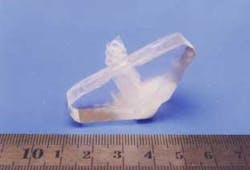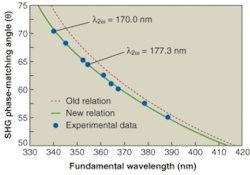New borate crystals promise deep-UV harmonic generation
The lithium triborate (LiB3O5 or LBO) family of nonlinear crystals—including cesium triborate (CsB3O5 or CBO), cesium lithium triborate (CsLiB6O10 or CLBO) and beta barium borate (β-BaB2O4 or BBO)—largely satisfy laser-industry frequency-conversion requirements from the visible to near-UV spectral regions. But requirements for coherent wavelengths below 200 nm have become increasingly evident over the past decade.
Advances in semiconductor photolithography, for example are creating demand for 193- and 157.6-nm coherent light sources, while emerging micromachining and material-processing applications also need deep-UV laser radiation. In addition, research scientists would like a widely tunable coherent light source down to 200 nm for laser spectroscopy and photochemical synthesis.
Although excimer lasers can emit some isolated wavelengths of coherent light in the UV and deep-UV spectral region with a high average output power, compact and efficient solid-state lasers with nonlinear optical (NLO) crystals in this spectral region are still needed. Important solid-state benefits include narrow bandwidth, improved beam quality, tunability, and relative ease of handling. Of course the performance of solid-state lasers in the UV and deep-UV spectral regions depends quite heavily on good NLO crystals, such as the borate deep-UV crystals that we have been developing over the last decade.
From BBO and LBO to KBBF
After growing the first BBO and LBO crystals more than a decade ago at the Chinese Academy of Science (Fujian Institute), we immediately knew that the capability of BBO to produce deep-UV coherent light was limited because the absorption edge of the crystal is determined by the energy gap of the triborate (B3O6)3- group (Laser Focus World, November 1989, p. 129). Calculations indicated that the energy-gap wavelength of the p-conjugated orbital tends to shift to about 190-nm. The LBO absorption edge is shifted to 153 nm, because the p-conjugated orbital in the planar (B3O6)3- group is destroyed by a tetrahedral coordination barium atom in the non-planar six-ring (B3O7)5- group. The space structure of LBO shows, however, that (B3O7)5- groups in the crystal lattice form the endless (B3O7)n→∞ helices, which do not favor large birefringent effects.
The birefringence of LBO is only about 0.045, which is too small to perform deep-UV harmonic generation. The same situation also occurs in the other borate crystals of LBO family, namely crystals with the (B3O7)5- group as the basic structural unit, such as CBO and CLBO. To develop new borate UV and deep-UV NLO crystals, we therefore turned our attention to the trigonal borate (BO3)3- group.
Calculations based on the discrete variational self-consistent multipolar Xα method indicated that if the three terminal oxygen atoms of this group are linked with other atoms (like B, Be) to eliminate the three dangling bonds, the energy gap of (BO3)3- group will shift to 150 to 160 nm. The calculations also showed that a borate crystal consisting of coplanar and dense (BO3)3- groups would possess a relatively larger birefringence and higher dij coefficients.1
From the above discussion several useful conclusions guided us to the search for new borate deep-UV NLO crystals. If we adopted the (BO3)3- group as the basic structural unit to search for new-generation deep-UV NLO crystals, the spatial structure of the new compound would have to satisfy three structural conditions: the (BO3)3- group must maintain a coplanar configuration; the three terminal oxygen atoms ought to be linked with other atoms, such as B, Be and Al; and the density of (BO3)3- group per unit volume must be as large as possible. Following these criteria, we quickly found that potassium difluo-diberryllo-borate KBe2BO3F2 (KBBF) is one of the rare compounds that can satisfy the microstructural requirements.
From KBBF to the SBBO family
KBBF is an excellent UV and deep-UV NLO crystal. The crystal has a wide transparent region (152 to 3664 nm), middle dij coefficient, and large birefringence (see Table 1). So we expected the crystal would achieve a very wide phase-matching range. However, KBBF is difficult to grow in large single-crystal sizes because it decomposes at a relatively low temperature (approximately 825°C) and exhibits a strong layering tendency, which makes it very difficult to grow samples thicker than a millimeter. There is no bonding between adjacent layers, and we have thus far achieved only partial success in growing crystals 20 × 10 × 1.8 mm in size.2
Difficulty in growing this crystal pushed us to search for other borate crystals that might offer the major structural characteristics of KBBF, especially the coplanar (BO3)3- group arrangement in the lattice, but without the layering disadvantage of KBBF. Consequently, a series of systematic syntheses and tentative crystal growths were undertaken from 1992 through 1994, resulting in a series of new borate crystals. The basic structural unit is the coplanar (BO3)3- group, including distrontium diberyllo-borate Sr2Be2B2O7 (SBBO), dibarium diberyllo-borate Ba2Be2B2O7 (TBO), barium dialumo-borate BaAl2B2O7 (BABO) and dipotasium dialumo-borate K2Al2B2O7 (KABO).3 Even though we achieved partial success in developing new borate crystals to replace KBBF for easy growth, KBBF still possesses the best linear and nonlinear optical properties. Moreover, KBBF also produces the shortest fifth-harmonic-generation wavelength achieved with NLO crystals to date.
The KABO crystal can be grown in large sizes with relative ease because special bridging oxygen atoms connect adjacent layers (see Fig. 1). KABO can achieve fourth-harmonic generation of an Nd:YAG laser (266 nm) and 193-nm wavelength output with sum-frequency generation (1064 nm + 235.8 nm → 193 nm). Meanwhile, the crystal is not hydrophilic and has good mechanical properties for cutting, polishing, and coating. Unfortunately, KABO exhibits strong absorption in the 193- to 300-nm spectral region, and we have not yet found an explanation.
Although the crystalline structures of SBBO and TBO are nearly the same as KABO, their optical quality is too poor for the phase-matching required for frequency-conversion applications. The BABO crystal should have the same optical properties as KABO, but we have not yet obtained a crystal large enough to measure its linear and nonlinear optical properties.
Deep-UV harmonic generation with KBBF
To date KBBF is the only NLO crystal to achieve deep- and even vacuum-UV second-harmonic generation (SHG) from 170.0 to 200 nm. In the measured and calculated phase-matching curves shown for type-I SHG, the solid line is calculated by the following Sellmeier equation (see Fig. 2):
null
To the best of our knowledge, 170.0 nm is the shortest SHG output wavelength that has been obtained by NLO crystals. The Sellmeier equations indicate that the crystal can further achieve 165-nm output with SHG, which means that KBBF can theoretically be used to generate the fourth harmonic of the total tunable spectral region of a Ti:Sapphire laser. A 1.8-mm-thick plate-like KBBF crystal is difficult to cut along the SHG phase-matching directions to produce deep- or vacuum-UV radiation, however. To solve this problem, we invented an optical-contact prism-coupling technique (PCT) that avoids the difficulty of cutting the crystals (see Fig. 3).4
Using this method, we produced 177.3-nm quasi-CW radiation, at the sixth harmonic of an Nd:YVO4 laser.5 In the experiment, a frequency-tripled Nd:YVO4 laser (Vanguard, Spectra-Physics; Mountain View, CA) provided a 355-nm fundamental wavelength with a 10-ps pulse train and a repetition rate of 80 MHz. A 1.3-mm thick KBBF crystal was used to make the optical-contact PCT device. At 3.5 W of fundamental pump power, 3.5 mW of output power was obtained at 177.3 nm.
Recently, the KBBF PCT device was also used to generate the fifth harmonic (from 156 to 160 nm) of a Ti:sapphire laser (see Fig. 4).6 The 157-nm wavelength is the shortest ever obtained using NLO crystals in a phase-matching process. In addition, an inspection tool with a 157.6-nm light source, for F2 laser lithography, is under development.
REFERENCES
- C. T. Chen et al., J. Appl. Phys. 77, 2268 (1995).
- C. Q. Zhang, C. T. Chen, Y. G. Liu and J. Y. Wang, J. Cryst. Grow. (Submitted).
- C. T. Chen, et al., Adv. Materials 11, 1071 (1999).
- C. T. Chen et al., Optics Letters 27, 637 (2002).
- T. Togashi et al., Opt. Lett. 28, 254 (2003).
- T. Kanai et al., J. Opt. Soc. Am. B 21(2) (2004) (in press).
CHUANGTIAN CHEN directs the Beijing Center for Crystal R&D at the Technical Institute of Physics and Chemistry in the Chinese Academy of Sciences, P.O. Box 2711, Beijing, 100080, China; he is also an editorial adviser to Laser Focus World; e-mail: [email protected].






